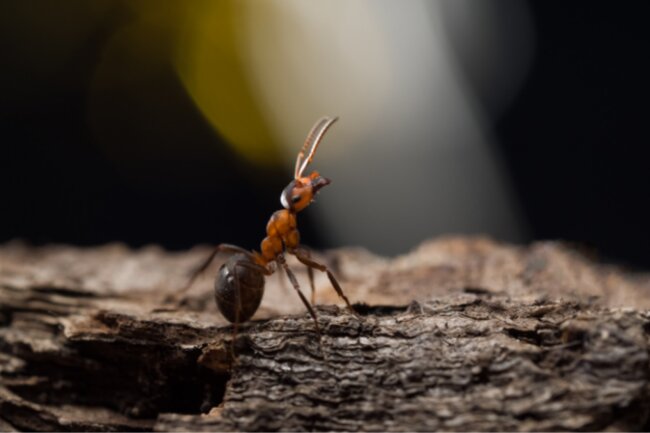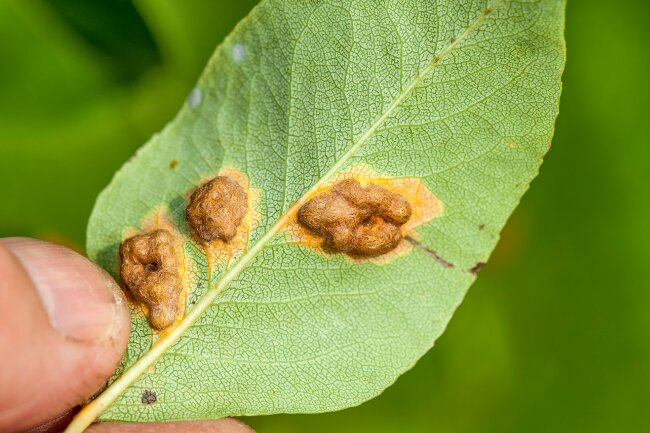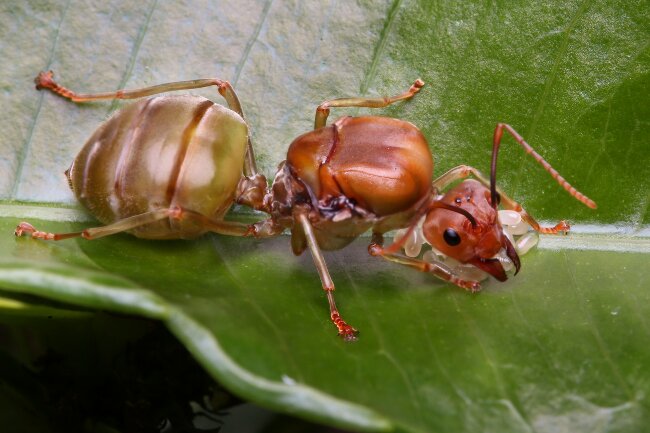Like all living things, ants can get sick. This can occur through a number of means, such as bacteria, viruses or parasites.
Contents
A tough life

We often paint ants as super beings, able to survive even the toughest conditions. Yet, they aren’t impervious to illness, and there are plenty of unpleasant ways to die if you’re a tiny ant.
How harsh your life is as an ant depends on part on your cast. Queen ants sit at the top of the tree. While she may have the strenuous job of giving birth to her many thousand offspring, once the first generation has grown up she’ll be waited on hand and foot, and protected at all costs.
| Disease | Description |
|---|---|
| Fungal Infections | Various fungal pathogens that affect ant colonies |
| Bacterial Infections | Bacteria causing infections and diseases in ant populations |
| Viral Infections | Viruses that can spread among ants and cause illness |
| Parasitic Infestations | Parasites such as mites and nematodes that infest ant colonies |
| Protozoan Infections | Single-celled organisms that can infect and harm ants |
| Wasp Parasitism | Certain wasp species lay eggs inside ants, leading to parasitism |
| Fly Infestations | Flies that lay eggs on ants, with larvae consuming ant tissue |
Able to spend plenty of time resting, with plenty of food and the constant care of her workers, she lives the longest and is the least likely to become ill, as after her initial mating flight she never leaves the nest again.
Drones are the males, whose sole purpose is to leave the nest and mate with a queen, dying shortly afterwards. Though they can get sick, their short lives mean there’s less time for viruses or bacteria to incubate and take hold.
| Disease | Signs and Symptoms |
|---|---|
| Fungal Infections | Discolored or deformed bodies, abnormal behavior |
| Bacterial Infections | Weakness, lethargy, loss of coordination, visible wounds |
| Viral Infections | Abnormal behavior, paralysis, visible abnormalities |
| Parasitic Infestations | Presence of external parasites, abnormal behavior |
| Protozoan Infections | Disorientation, abnormal movement, swollen body segments |
| Wasp Parasitism | Ants behaving unusually, larvae of wasps visible on the ant |
| Fly Infestations | Presence of fly larvae on the ant’s body or in the nest |
Of all castes, it’s the workers that are most likely to become ill. They have the dangerous tasks of going out and hunting for food, leaving them open to all kinds of sicknesses.
Also read: Do Ants Carry Disease? Can it Affect Us & How?
Fungal

There are a number of fascinating fungal infections that can affect ant species, particularly in tropical areas. Some of these fungi have the amazing ability to control the ant’s body, such as the zombie ant fungus.
This fungus uses chemicals to make the ant climb up high and then grip on. The fungus then bursts through the back of the body and drops its spores on insects passing below, infecting the next generation.
Bacterial
Not all fungi are bad for ants. Leaf Cutter ants have a fungal garden, which they feed their leaves to. The fungus is then food for the ants. To help this relationship thrive, special bacteria grow on the ant’s skin which produces antibiotics that kill off other fungi, as this would threaten the more valuable fungus they live off.
So like humans, ants can host bacteria for their own benefit, as well as being infected with harmful varieties. Though research is sparse on harmful bacteria that target ants, infected ants are likely to act strangely or be less able to perform tasks.
Virus
There is a wide range of viruses that can spread in ant species. Unlike bacteria, they are unlikely to have advantages. Deformed wing virus is one example that is also common in bees. Though this virus is unlikely to affect workers, it could decimate the winged males and females that emerge to start the next generation.
Parasite
Parasites may not technically be an illness in the purest sense, but they certainly do make ants sick. Euryplatea nanaknihali is a tiny fly that lays its eggs on an ant’s exoskeleton. The egg then burrows into the ant, living at first in its body, before moving up into its head and eating its jaw muscles and then its brain.
Eventually, it eats the ant’s neck, causing the head to fall off. The happy little larva then lives out its remaining childhood in the ant’s head.
Other parasites can include less deadly hitch-hikers, such as nematodes and mites. These may infect the individuals without leading to their eventual death.
Treatment
Ants have amazingly elaborate ways of controlling outbreaks of disease. Firstly, ants that are unwell tend to avoid entering the nest, sacrificing their own comfort to prevent the spread of the illness.
Another common containment mechanism has been the use of ‘undertaker’ ants. These ants remove the dead from the nest and place them outside on a midden. In general, these ants mix less within the nest, again reducing the risk of disease spread.
Some ant species have also been found to care for the sick, cleaning them regularly to try to remove dirt and bacteria.
Research has found that ants ingest their own formic acid to disinfect their insides of bacteria. They also use it to disinfect their young and eggs, in order to prevent fungal infections.
Also read: 10 Different Methods That Explain How Ants Survive the Winter
Do ants carry germs?

The term ‘germ’ is often used in a very unscientific way, to describe anything potentially dirty. However, germs are simply microorganisms, such as bacteria and viruses. Though some are linked to disease, many have other natural functions and may live within other animals or plants, in the soil or on surfaces.
Ants, therefore, are always likely to carry some kinds of ‘germs’ on their skin or within their bodies, either contained in substances that are attached to them, such as soil, or simply living on or in themselves.
For example, leafcutter ants have been found to carry certain kinds of bacteria on their skin that kill off unhelpful fungi that would attack or take over the fungi they grow within their nest to feed on. These bacteria are therefore very helpful to the ants.
| Preventive Measures | Management Techniques |
|---|---|
| Maintaining Hygiene | Regular removal of dead ants, keeping nest clean |
| Controlling Environmental Factors | Providing optimal conditions for ant health |
| Quarantine and Isolation | Separating infected individuals or colonies |
| Boosting Immune System | Providing proper nutrition and access to water |
| Biological Control | Introducing natural predators or parasitoids |
| Chemical Control | Using ant-specific insecticides with caution |
| Research and Monitoring | Continuously studying ant health and monitoring populations |
While the transfer of some germs may occur, it’s unlikely that these would impact human health in any significant way.
Also read: Wondering if Ants Poop & Urinate? (Explained Here)
Risky numbers
The fact is that ants both survive illness because their large numbers allow them to sacrifice some to save others, and are more prone to it because of their dense living conditions.
Yet, though many species suffer from some very strange and wonderful illnesses, they also rarely see these illnesses wipe out their colonies. So while it may mean an unpleasant end for some, the nest will survive.

